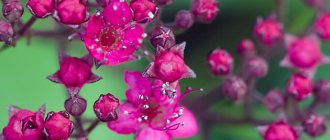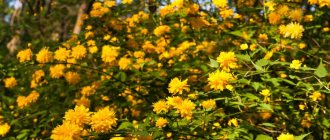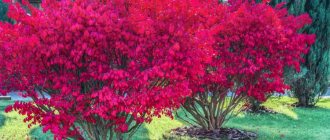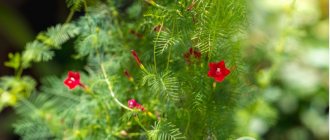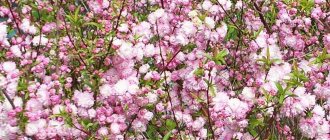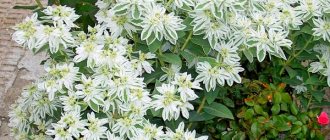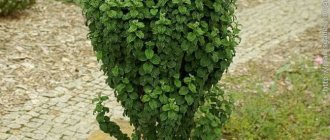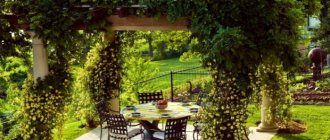Spiraea is one of the most profusely and beautifully flowering tree-like ornamental shrubs.
There are almost a hundred species, providing a variety of sizes and shapes:
- height can range from several centimeters to two meters;
- there are pyramidal, cascading, weeping and others;
- are spring-flowering and summer-flowering;
- flowers can be white or pink;
- The shape and shade of the leaves are different.
The most popular species is Japanese spirea. It looks interesting already in early spring, when the reddish leaves bloom.
It blooms throughout the summer, the branches are decorated with many pink flowers with long stamens. Shades may vary depending on the variety, as well as the height of the plant: from 30 cm to 1.5 m.
Decoration of the site
The use of Japanese spirea in landscape design is very common, since among the significant selection of species you can find ones suitable for realizing any idea.
Excellent for forming both clipped and free-growing plants, or a border for zoning an area, original design of flower beds, and framing ordinary trees.
They look unusual in plant compositions, beautifully setting off the greenery of the lawn, low-growing varieties, especially with yellow-orange leaves, are used for decoration, rock gardens or.
Taller bushes can grow individually in different parts of the garden or near the house. Spiraea can completely fill a surface, such as a slope.
Variety of species
One of the plants - many varieties with noticeable differences. Different options can be combined for greater effect.
The most common spirea are:
- Fortune
. A tall shrub with erect branches and long reddish leaves, which turn green in summer and bluish at the bottom. The flowers are bright pink, fluffy from the stamens. - Macrophylla
. This variety is distinguished by large leaves with jagged edges and inflorescences of a rich crimson hue. In order for the upper part of the growing shoots to get a bright color, it is necessary to cut the plant to 10 cm before the buds begin to open. It begins to bloom at the end of July. - Shirobana
. The height is no more than 80 cm. It looks very unusual, since the initially white inflorescences change color to pink and then to red. - Little Princesses
. Compact bush (up to 60 cm) with delicate pink-purple inflorescences and dark green foliage with sharp tips, forming a compact crown. The shoots are light brown. Flowering time is July and August. - Reddish
(Ruberrima). Height up to 1.3 m, distinctive feature are carmine-red flowers. - Dark red
(Atrosanguinea). Reaches 70 cm, new shoots are bright scarlet, flowers are carnation red. - Alpina
. Dwarf shrub (30-40 cm) with light pink flowers and green leaves. - Golden princesses
. A low, up to 1 m, shrub, distinguished by yellow leaves, with which pink flowers are in harmony. - Goldflame
. Young leaves are yellow-orange, gradually they change color and acquire a bright yellow, then a green-yellow tint. The flowers are pink-red. - Spirea Bumalda
- it is a hybrid of Japanese and white-flowered. The crown is neat, spherical, the flowers are painted in light and dark shades of pink.
In the photo Japanese spirea golden princess
In the photo, Japanese spirea goldflame
Types and varieties of spirea shrubs
Today there are more than 90 varieties of spirea. They differ in the location and shape of the inflorescences, height, and appearance of the bushes.
Arguta
It grows up to 2 meters high, and stands out among all varieties for its early flowering. Appearance characteristics:
- arched thin shoots;
- small bright green leaves;
- small umbrella inflorescences;
- graceful serrated foliage and profusion of flowers.
Arguta is unpretentious and can be planted in urban areas. Often used when forming long hedges.
Boumalda
The height of this variety of shrubs reaches 80 cm. Distinctive features are:
- leaves turning bronze-red or bright orange in autumn;
- carmine-colored flowers collected in corymbs;
- dome-shaped crown;
- vertical arrangement of shoots;
Spiraea Boumalda is often used to form small hedges in areas with partial shade.
Wangutta
The Vangutta variety shrub is planted to create a high hedge - up to two meters. It gains color in the second half of May. Shoots should be pruned only after flowering has finished. External characteristics:
- cascading arched branches;
- small leaves of bright green color, whitish on the underside;
- large inflorescences of snow-white spherical flowers;
This is a variety that is characterized by abundant flowering, unpretentiousness, and resistance to winter cold.
Grefsheim
A shrub of this variety with hanging red branches grows up to two meters, making it suitable for street hedges. Begins to bloom in May with white flowers. The leaves change from gray-green in summer to golden yellow in autumn. The variety tolerates pruning and frost well, but is sensitive to heat and dry weather.
Gray (ash)
This variety got its name because of the gray-green hue of the upper part of the leaves, while the lower part is slightly lighter. This variety of spirea blooms from May to mid-June. On long shoots there are snow-white shield-shaped buds. The inflorescences are located on the shoot along its entire length.
The branches are spreading, long, and resemble the shape of an arch.
Meadowsweet Average
It grows from 1 to 2 m in height and begins to bloom profusely in June. External characteristics of the variety:
- brown branches;
- oblong serrated leaves;
- The flowers are white, the crown of the bush is rounded.
The variety does not require special care. Meadowsweet is frost-resistant and takes root well on any soil.
Frobeli
A bush of medium height (up to 150 cm) with powerful straight shoots of red-brown color. The flowers are pink-purple, collected in large corymbs. The variety is light-loving and requires good drainage and moderate watering. Faded shoots must be cut off, and at the end of the season only 30 cm of stumps should be left from the ground.
Japanese
A medium-sized variety, reaching a height of 60 cm. It blooms with beautiful, abundant red-pink inflorescences up to 4 cm in diameter. It is resistant to cold, tolerates partial shade well, but grows slowly.
Decumbens
A low-growing variety that does not grow higher than 30 cm. This is ideal for planting near a fence in the foreground. Spiraea blooms with white flowers 3-5 cm in diameter. It is advisable to plant it in a sunny area and remove faded inflorescences.
Densiflora
Often this spirea is planted for low hedges up to 80 cm. Green oval leaves turn orange in autumn. Large inflorescences up to 10 cm in diameter have a bright pink hue. The variety is unpretentious, but from rare watering it begins to develop worse.
Nipponica Snowmound
The shrub of this variety is characterized by a flowering duration of 2 months. In addition, it is different:
- two meters high;
- lush crown with a diameter of 2-4 meters;
- white flowers that completely cover the shoots.
To decorate hedges, bushes that are 3-5 years old are used, which should be renewed periodically.
How to choose a landing site
In addition to its beauty, gardeners love to grow spirea because of its unpretentiousness and frost resistance; it thrives in various climatic zones.
It is able to grow well within the city, it is undemanding to the soil, although it grows more luxuriantly in rich soil. Therefore, it is better to prepare and use leaf soil, adding peat, turf and sand.
When choosing a place to plant Japanese spirea bushes, you must remember that it loves the sun, which means you need to take care of the lighting. You can plant it in partial shade, but flowering will be less abundant.
For a green hedge, the distance between bushes in rows and between them is 40 cm, in groups 0.5-0.7 m. The best month for planting is September.
How it is used in the design of summer cottages - planting and caring for the plant and methods of its propagation.
Why is propagation of viburnum Buldenezh so difficult? about this ornamental shrub, so that the summer cottage always blooms and smells from the aromas of this plant?
How to properly care?
Japanese spirea "Golden Princess": description, planting and care
Caring for spirea of the "Goldflame" species consists, like most plants, in watering, loosening the soil, and fertilizing. Watering is necessary regularly, but moderately. Water should not be allowed to stagnate. You need to especially carefully monitor the bushes in the heat, preventing the top layer of soil from drying out. This slows down the development of the plant and worsens its decorative qualities.
The roots need oxygen supply, so every time you water, you also need to loosen the soil. It is also good to mulch using peat or compost.
The bush will bloom profusely only if the soil is fertile. You can feed spirea with organic and mineral fertilizers. During the growing season, you need to feed the bush no more than 4 times. It is advisable to combine this procedure with watering.
An important point in plant care is pruning, which allows you to beautifully shape the bush. It should be started when the spirea is 4 years old from the moment of planting. There are several pruning options: sanitary, rejuvenating and shaping.
After the winter period, it is important to remove shoots from the bushes that have dried out or been damaged by frost. In autumn it is necessary to cut off the inflorescences
It is advisable to also shape the crown in the autumn months so that it is lush. The plant can be given any shape.
Young bushes need shelter for two years. To do this, you need to loosen the soil and spread mulch in a layer of 15 centimeters. Place burlap on top and sprinkle fallen leaves on it. Then the stems must be bent to the ground, secured with staples and wrapped in non-woven material. When the temperature is fixed at values above zero, you can remove the shelter and remove the staples, freeing the shoots.
Reproduction methods
The most convenient and common planting option is cuttings, green or woody.
To do this, take non-flowering shoots and cut them so that the length is no more than 15 cm. You can use both the top and the middle. Leaves from the area that will go underground are completely removed. Next, they are planted in the ground; an enclosed space or greenhouse is best.
High humidity is important
, therefore, before covering the cutting with a film with holes for air to pass through, you need to spray it with a spray bottle. Spiraea usually takes root easily, but can be treated with a growth stimulator.
Propagation by seeds is not suitable for hybrid varieties. In other cases, you can try, but you must remember that only part of the sprouts of dwarf or yellow-leaved varieties will have the same properties, so selection will have to be made.
It is recommended to plant them in spring in wooden boxes with moist soil. While waiting for the exit, they mulch the ground with peat, and after a few months they pick. At first, spirea grows as an even shoot and begins to bloom only after three years.
In addition to cuttings, there are other methods of vegetative propagation. For young bushes, no older than four years, division is suitable. It is carried out in the fall or spring before the buds appear.
The plant is dug up, for convenience, the roots are cleaned and divided into two or three parts. Sometimes it’s easier not to remove it from the ground, but simply separate it along the edge.
You can also use layering for propagation: the branch is pressed to the ground and sprinkled with soil, after a while it takes root. Such seedlings have a high survival rate.
Growing Drummond phlox from seeds - when to plant seedlings
Phlox drummond is an annual plant. It got its name in honor of the English botanist who was the first to bring the flower from America to Europe. It is considered one of the favorite plants of gardeners; thanks to its attractive appearance, it decorates flower beds, mixborders, gardens and vegetable gardens. Ideal for decorating balconies, window sills and terraces. Growing drummond phlox from seeds (you will learn when to plant further) is accessible even to a beginner, the only drawback is that the process is labor-intensive. But the result is worth it, the bright flowers will fascinate with their beauty all season long until frost.
- How to choose seeds
- When and how to plant seeds
- Sowing seeds in open ground
- Sowing seedlings
- Seedling care
- Varieties and types
Seed selection and preparation
To sow seedlings at home, you need to choose high-quality seeds. It is better to do this in trusted stores and from a reliable manufacturer. The quality of future plants largely depends on the quality of planting material.
You can plant the seeds immediately, without preparation. Or you can carry out pre-sowing treatment, for example, soak them in a solution of a growth stimulant drug, for example, “Zircon”, “Energen”, “Epin-Extra”. You need to act according to the instructions indicated on the packaging.
By the way, as can be seen in the photo, the seeds of this flower crop are of normal size, so it is convenient to process and sow them.
Easy care
Spiraea is very unpretentious and caring for it is not difficult even for an inexperienced gardener.
It is important to know that excess moisture can be harmful, so you should water it moderately, this is quite enough for full growth.
Particular attention must be paid to watering spring plantings to give them the opportunity to get stronger. If the soil in which the shrub grows is not rich enough, then it is worth feeding it once or twice a season. Fertilizers are used in early spring and mid-summer.
For fertile soil you can do without them. After loosening and watering, it is useful to mulch. This will help retain moisture, keep out weeds and provide organic nutrition.
Pruning is important and necessary
An important stage in care is pruning. In the first months of spring, when the plants are just awakening, dry and diseased branches are removed.
Shoots are pruned to significantly developed buds, and small ones are completely removed. If this is not done, then after three years the upper part of the shoot will tend to the ground and dry out.
Periodically, when the inflorescences become smaller, the plants are cut to fit the stump. New shoots will grow by next season. In summer, faded inflorescences are gradually removed so that the bushes do not become depleted.
After flowering has passed, you can cut off spent shoots to create a more compact appearance. After pruning, you can fertilize the soil.
The plant loves sunlight and moderate amounts of water. It is resistant to cold, but in very severe frost, individual shoots may freeze. If desired, the shoots are gathered into a bun by the ends for better protection.
Looks good with a variety of plants
Japanese spirea looks great in compositions with other ornamental plants, for example, dahlias, mackerel, and dogwood. In addition, it does not suppress the forms growing nearby.
Spiraea Japanese shirobana will decorate any garden
By choosing combinations, you can create an original decoration of the site. Interesting options are obtained with conifers - spruce, thuja, juniper, pine.
Gardeners are happy to plant spirea along with other shrubs, especially lilac and mock orange.
Thanks to its variety of properties, the ornamental shrub will become a wonderful decoration for the garden. Different shapes and sizes, shades of flowers and leaves will not allow monotony.
Care is simple, which is rare for ornamental plants, and the flowering never ceases to amaze with its splendor. That is why spirea is ideal for landscape design and is simply irreplaceable in modern areas.
Height: 70 cm.
Width: 40 cm.
We bring to your attention ready-made blocks for constructing a hedge. The plants are already formed, all that remains is to plant them in a permanent place.
Spiraea japonica Goldflame is a fast-growing deciduous shrub.
The height of adult specimens reaches 0.5 m in height.
The shape of the crown is spreading, uneven, dense.
The variety is highly decorative. The leaves are ovate, glossy, dark yellow, with red-orange tips. The flowers are small, pink, collected in fairly large inflorescences. Flowering begins at the end of June and, with timely removal of faded flower stalks, lasts until the end of August.
You can purchase blocks with Japanese Spiraea Goldflame on the trading platform of our garden center or by placing an order by phone; we also have an online store for your convenience.
Spiraea japonica Goldflame grows well in sun and light shade. Prefers moist, nutritious loam soils. During dry periods, additional watering is required. Responds well to the application of complex mineral fertilizers. The soil should not be loosened deeply, since the root system of all spireas is superficial. Shaping trimming is recommended.
When purchasing from our garden center, consultants will provide complete information on planting and caring for spirea; if self-planting causes difficulties, you can order a planting service from us.
Used to create free-growing and formed, low hedges and borders.
All spirea are resistant to pests and diseases. Subject to the conditions of agricultural technology, it is enough to carry out preventive treatments with preparations (Iskra, Inta-Vir, Actellik), and then with preparations containing copper (HOM, Abiga-Pik).
To maintain the health and good appearance of plants, we offer a comprehensive garden care service.
Winter hardiness is high; plants do not require shelter for the winter.
Spiraea japonica Goldflame is an ornamental small semicircular shrub, a member of the Rosaceae family, native to China and Japan. Grows up to 80 centimeters. The annual growth is about 10 centimeters. A description of Goldflame spirea will help you understand how to plant this beautiful plant correctly.
Spiraea of this species is one of the fastest growing shrubs among Japanese spirea. But in general, such growth in plants is considered to be quite slow.
Japanese pink spirea "Goldmound" (container p9)
80802 https://agro-market24.ru/catalog/item/spireya_yaponskaya_rozovaya_goldmaund_goldmound_konteyner_p9/ Agro-Market https://agro-market24.ru/upload/iblock/3fb/3fb79271286a8f64d2a37dab69b44329.jpg
https://agro-market24.ru/catalog/item/spireya_yaponskaya_rozovaya_goldmaund_goldmound_konteyner_p9/ 382 in stock
Spiraea japonica variety "Goldmound"
- a low-growing cushion-shaped bush about half a meter in height and 0.8-1 m in girth. The foliage is rounded-oblong, greenish-golden or light green in summer and bright orange in autumn. Flowering time is the first 2 summer months. It blooms with delicate pinkish-lilac inflorescences that form many small flowers. The plant is resistant to frosty winters, but in regions with harsh climates it needs shelter. Spiraea Goldmound is not too demanding in terms of care and choice of area for planting; it prefers sunny areas, but also feels good in semi-shaded corners.
Spiraea Goldmound looks great both in a single flower bed and in combined compositions; it is used to create low hedges and borders, decorate rock gardens, rocky gardens, landscape compositions, and lawns. Suitable for decorative growing in containers.
Advantages of the Japanese spirea variety "Goldmound"
- low compact bush that does not require much space for planting
- interesting leaf color - yellowish-green in summer and bright orange in autumn
- long flowering - June-July inclusive
- very decorative appearance during flowering - delicate pinkish inflorescences give the bush the appearance of a delicate cloud
- undemanding to care and planting site
- good winter hardiness
Advantages of buying spirea seedlings at Agro-Market24
- We value every customer, therefore we sell high-quality seedlings with a maximum survival rate
- Delivery is carried out carefully and in the shortest possible time
- Loyalty program, sweepstakes, promotions and bonuses
- Compliance with varietal and taste qualities
- Order seedlings from our website and enjoy the beauty of spirea flowering in your garden
Article: 80802
Shipping of orders will begin on September 10, 2019. Hurry up to place your order now to reserve your goods and receive priority shipment. More information here.
100% satisfaction guarantee
from goods from your order
Trees from our nursery
Fully adapted to harsh Russian winters
Minimum order amount 1300 rub.
All orders are sent immediately after confirmation by the operator.
We control the expiration date
All products, without exception, are checked at the warehouse
Be confident in the quality of planting material
Favorable delivery from only 300 rubles
Accelerated delivery time for your order and a half-reduced percentage for sending money thanks to a close partnership with Russian Post
Japanese pink spirea "Goldmound" (container p9)
What does Spiraea Goldflame look like?
The decorative value of the plant lies in the multiple changes in leaf color throughout the year and its naturally beautiful shape.
The crown habit of the shrub is dome-shaped. Spiraea grows very densely, the bush is thick and lush.
The leaves of the bush are elongated, ellipse-shaped with a serrated edge. Fresh, young leaves of the plant are orange in color. With age they lighten and become yellow.
If spirea is planted in acidic soil, the color of the leaves will be brighter. Also, the color of the leaves depends on the amount of sunlight that falls on the bush: the more sun, the brighter the color of the leaf. The decorative effect of the plant is achieved thanks to the unusual beautiful coloring of the leaves.
During flowering, the leaves of the bush become light green. Spiraea Goldflame blooms from late June to mid-August. Small flowers, lilac, with a hint of pink, are collected in neat inflorescences and exude a delicate, pleasant aroma.
Description of the plant
Spiraea goldflame is a deciduous shrub with a height of sixty to eighty centimeters.
Throughout the year, this plant changes the color of its foliage many times - from deep green to bright yellow, hence the telling name goldflame, which means “golden flame” in English. The foliage itself is lush and uniform, which greatly attracts gardeners and landscape designers - such a shrub will look advantageous in any garden. During flowering, the leaves reach a rich light green hue, and the small flowers take on a pinkish-purple color. The leaves themselves have an elongated shape with sharp, tooth-like edges.
The color of the foliage also depends on the age of the shrub and the amount of sun hitting the foliage. Young Spiraea goldflame will take on an orange color, and with age the foliage will lighten to light yellow shades. Also, with an abundance of sun, the leaves of spirea goldflame will be bright, saturated colors, and with a lack of sunny color, they will be darker and more restrained.
Over the course of a year, the volume of the bush increases slightly, by only ten centimeters in diameter. Goldflame spirea blooms in the summer - from June to August - for fifty days. At this time, small pink flowers appear on the bushes, which gather in small inflorescences and emit a sweet, pleasant aroma.
Features of proper care
The Japanese spirea shrub is unpretentious to its conditions. It easily takes root in modern urban conditions on different soils. Feels better in loose, moist soil with good drainage. An adult bush can tolerate mild frosts and short droughts without harm. It is better to protect young animals from the cold, especially in the first year after planting.
To protect spirea from freezing, you need to perform the following manipulations:
- loosen the ground around the bush;
- mulch it;
- Throw dry leaves or burlap under the branches;
- fasten the branches themselves together and bend them to the ground;
- fix their position;
- cover the bush with insulation.
These simple steps will help protect fragile bushes from temperature changes.
Spirea pruning
Spiraea responds well to pruning. It is recommended to shorten the old branches of the bush in the spring to preserve its decorative appearance. The next trimming should be done in August, when flowering ends, to remove dry inflorescences.
Spiraea Goldflame does not require careful care. This is what makes it a suitable plant for urban flower beds, which are often not provided with sufficient care, for gardens of schools and institutions, and for private plots, the owners of which do not have the time or opportunity to create special shelters or conditions for plants.
Spirea Goldflame in landscape design
Japanese spirea is well suited for creating compositions, borders, rocky gardens, alpine slides, etc.
It is optimal to plant this type of spirea in early spring, before the buds begin to bloom. Before planting, it is recommended to carefully inspect the root system, remove dry and damaged root shoots and shorten overgrown ones. The ground part of the bush also needs to be trimmed and its shape adjusted.
Japanese spirea bushes should be planted at a distance of at least 50 centimeters from each other, because the root system of the plant branches very widely and actively. The hole must be dug with steep walls, with a volume 1/3 larger than the volume of the root system. You shouldn’t plant spirea right away in a dug hole; it’s better to let it air out for a couple of days. It is preferable to plant bushes on a cloudy or even rainy day.
A layer of drainage is poured into the bottom of the prepared pit, and soil mixed with sand and peat is placed on top of it. Lower the roots of the plant into the hole, straighten it and cover it with soil, compact the soil well and water it generously.
Planting and care in open ground
Before planting Goldflame spirea, you need to understand whether you are ready to pay attention to the shrubs. If you care for plants incorrectly, their life expectancy is reduced and their decorative characteristics are lost (the color of the leaves becomes more faded and the height of the bush decreases).
Planting is recommended in mid-spring . If the soil does not warm up enough (up to a temperature of +12°C), then signs of disease may appear on the root system, which will provoke the death of the bush.
Feeding and reproduction
Ornamental shrubs should be fed after pruning in mid-summer, and the soil should also be mulched annually with peat or crushed bark.
It is necessary to maintain moderate watering, increasing it only during periods of active drought. Young plants need more abundant watering, but for older plants it can be reduced. Young spirea also respond well to loosening the soil.
Spiraea bushes are best propagated by cuttings or layering. The plant is cut in summer, starting in mid-June. The shoot is planted in a mixture of equal proportions of sand and peat and sprayed generously several times a day to maintain an increased level of humidity.
During the cold season, the shoots are covered and then planted in the ground in the spring. Spiraea is propagated by layering in early spring. The lower branches of the bush are bent to the ground and fixed at a horizontal level. Sprinkle earth on top.
It is necessary to provide the cuttings with regular good watering, and then by autumn they will transform into independent bushes.
General information
External data of spirea
The foliage is dense and looks good in any planting. When Spiraea goldflame blooms, the flowers become purple in color and the foliage turns light green. The leaves are pointed and elongated. Spirea blooms from the beginning of summer until the end. The flowers are collected in small inflorescences, their aroma attracts insects, which gives reason to plant it next to the hives.
The color of the foliage directly depends on the illumination of the shrub and its age. A young bush usually has orange colors; as it matures, it becomes yellow. The brighter the area is illuminated, the richer the color of the foliage and, conversely, in shaded areas, the spirea will be darker.
Several rules for planting shrubs
First of all, it is important to choose a illuminated area; without sunny color, Japanese spirea will become just a green bush with little flowering. Due to the basal shoots, the bush increases in volume; you need to give a good gap between plantings
Due to the basal shoots, the bush increases in volume; you need to give a good gap between plantings.
When purchasing planting material, it is important to inspect the roots; they should not be dried out. The shoots should look as alive and flexible as the buds on the branches.
Planting spirea consists of several points:
- The size of the hole that should be dug in advance depends on the roots of the seedling. Its diameter should be 1.5 times larger.
- Drainage can be made from scrap materials, or can be purchased at the store. Its layer will be 20 cm. Planting is done in a mixture of turf soil, humus, sand and peat in a ratio of 3:2:1:1.
- The seedling is placed in a hole with the roots straightened and covered with prepared soil. This is followed by abundant watering and mulching.
Pest control measures
Spiraea tolerates diseases and pests quite easily. Especially if you start fighting them in the early stages. The most dangerous pest for this beautiful bright shrub is the spider mite. If cobwebs appear on the leaves of the spirea, the leaves wither and fall off or become covered with holes, these are sure signs of a mite.
A good antidote for spider mites is phosphamide. The bushes are sprayed with its solution until the pest is cured.
In summer, spirea can be damaged by aphids. Pirimor effectively helps in the fight against it. To the above description we can add that the average age of Goldflame spirea is 15-20 years; after this period, the bushes in the compositions must be replaced.
Champion among plants with yellow foliage. It is distinguished by multiple changes in shades of yellow foliage throughout the season.
Crown diameter of an adult plant:
1m
Adult plant height:
0.8 m
Description
Japanese Spiraea Goldflame is a champion among plants with yellow foliage. It is distinguished by multiple changes in shades of yellow foliage throughout the season.
A beautiful dense shrub up to 0.6 - 0.8 meters high, up to 1 meter in diameter with young leaves of orange-red or bronze-golden color. They then turn bright yellow, then yellow-green at the time of flowering. After flowering, the fiery colors of the foliage return. The autumn color of the leaves is copper-orange with gold (on acidic soils it is brighter, a purple color is added). Sometimes variegated leaves appear on the bush. The leaves are oblong, serrated along the edges, 5-8 cm long. Slow growing, annual growth is 0.1 m in height and 0.1 m in width. The flowers are small, bright pink, collected in corymbs. Flowering period: late June - mid-August, average flowering time - 50 days, abundant flowering. It tolerates moderate frosts well and will not cause much trouble for those who do not have the opportunity to create special shelters. The variety is light-loving, but also tolerates partial shade; the leaves acquire a bright color in sunny areas; in the shade they turn green. It is not picky about soil, but prefers moist, fertile, loose soil.
Care Guide
Spring pruning is recommended to shorten the shoots, leaving them 15-20 cm high from the soil level. In summer, you can remove faded inflorescences to maintain the crown in a decorative state. It is necessary to cut out emerging green-leaved or variegated shoots. To obtain brighter autumn color, it is recommended to grow in acidic and medium-acidic soils. During particularly cold winters, the surface part may freeze out, but in the spring it is restored very quickly. Used in single and group plantings, to create low hedges and to decorate ponds. Looks good with conifers, other spirea, barberries, and bladderworts.
- Water the plant moderately but regularly, especially during dry and hot periods.
- After each watering, the soil must be loosened; this is especially important for young bushes.
- Loosening allows air to penetrate to the roots and is also removed.
- After watering, the soil under the bush can be covered with peat or compost to retain moisture for a longer period.
Every year organic and... Fertilizing is carried out 3-4 times a season. At the same time, after applying fertilizers, the bushes are well watered. This regime will maintain the health of the bush and its beautiful appearance.
Plants are planted in spring or autumn, depending on the flowering time of the variety.
Before planting seedlings, it is recommended to prepare the soil. To do this, you need to dig a hole, the size of which should be 25% larger than the root system of the plant. Mix the soil with peat, river sand, turf and leaf soil. The depth of the hole should be at least 50 cm. Drainage is laid out at the bottom, and part of the prepared soil is poured on top. The seedling is positioned so that when buried, the root collar remains at ground level.
Spiraea bushes are planted at a distance of 40 cm when planting for, and at a distance of 80-100 cm when planting in landscape design compositions. Almost all varieties of spirea are frost-resistant and do not require additional shelter. But if young bushes are planted, and the winter is predicted to be frosty, it is recommended to insulate the roots and young shoots with sawdust, thick paper or foliage.
Diseases and pests
The plant is resistant to almost all diseases. But insects attack spirea constantly.
The most dangerous are:
- rose leaf roller;
- spider mite;
- aphid.
The leaf roller appears at the end of spring. She chews leaves. If emergency measures are not taken, the shoots will remain bare. Aphids suck juice from leaves and damage stalks and shoots. To destroy these pests, “Pirimor” is used.
If a cobweb appears on the bush, and holes appear on the foliage and inflorescences, it means that the spirea has been attacked by a spider mite. If the necessary measures are not taken, the leaves will soon dry out and fall off. Spider mites reproduce very quickly in hot, dry weather. To process shrubs you can use:
- "Phosfamide";
- "Acrex";
- "Karbofos".
Reproduction methods
All types of spirea reproduce with the help of, the only exceptions being hybrid varieties. Plants can also be propagated by layering.
When propagating using seeds, you must:
- Pre-prepare the container where the young plants will grow. A wide box filled with loose, fertile soil may be suitable for this.
- You can prepare the soil yourself by mixing turf soil, peat, compost and river sand in equal proportions.
- Sowing is recommended in early spring.
- After which the soil is moistened, mulched, and the container is transferred to a warm, well-lit room for seed germination.
After 1-1.5 weeks, the first shoots begin to appear. They must be regularly watered with soft water at room temperature using a spray bottle. 2.5-3 months after germination, you can dive into the ground. This process is carried out in the evening or in cloudy weather so that the young roots can adapt to the new soil without strong sunlight.
When propagating using cuttings you must:
- Pre-prepare the material. To do this, segments 10-12 cm long are cut from semi-lignified healthy and strong branches formed this year.
- Before planting, cuttings are recommended to be given stimulating solutions for rooting.
- Next, the branches must be buried in the prepared soil and watered regularly.
- When planted in mid-summer, a good root system will be formed by autumn.
Spiraea bushes can also be propagated using layering, while all the characteristics of the mother bush are preserved, and flowering begins the very next year after planting.
Reproduction of spirea by layering:
- To get a good young bush, you need to bend the outer branches along the perimeter to the ground and secure them in a small depression without separating them from the main bush.
- Fill the hole with earth and keep the mounting area moist at all times.
- This process is carried out in the spring. The following year, the rooted young plants can be separated from the mother bush and moved to a new place for permanent growth.
- During rooting, all developing buds and inflorescences must be removed so that all the strength goes to the development of the bush.
For varieties whose flowering period begins in spring, pruning is carried out immediately after flowering. At the same time, diseased and dry branches are removed, as well as branches whose age has already exceeded 5 years. This will give the young stems room to grow and develop.
It is impossible to shorten healthy faded branches, as the lateral shoots will begin to grow wildly, on which small and unsightly inflorescences will form.
You can also disrupt the beautiful and natural shape of the bush. Pruning for other varieties is carried out in early spring. It should be started on bushes that have already reached the age of 4 years. They do this so that the correct shape of the bush is maintained. When pruning, old, diseased and dry branches are removed.
